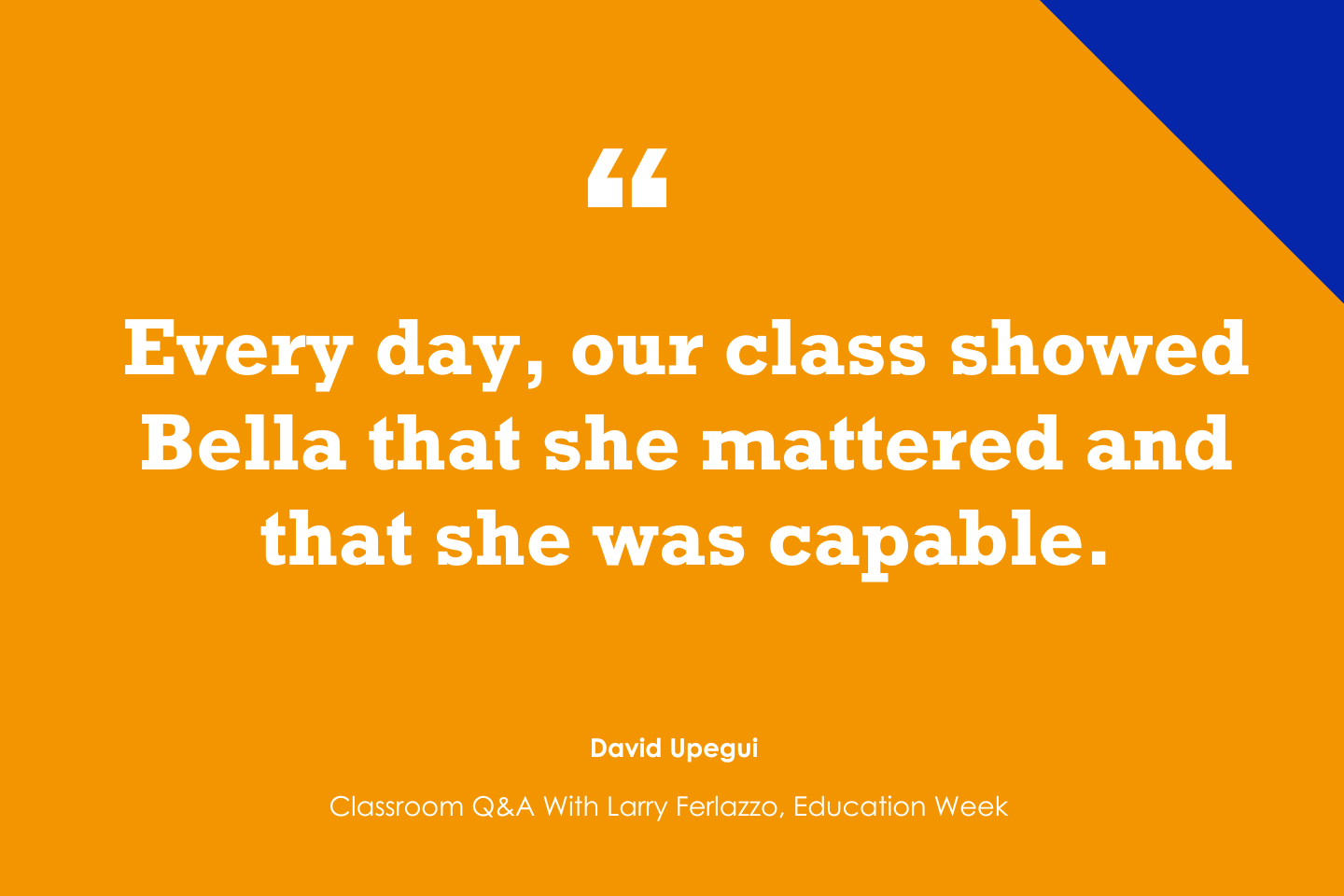
As regular readers know, I’ve been doing the Classroom Q&A column over at Education Week for thirteen years.
And I plan to continue doing it for quite a few more years.
I have so many contributors now, though, that there really isn’t space there for my annual thematic compilation posts, where I collect links to all the posts on particular topics.
So, I’m starting to do it here instead, and this is the third one.
Today’s theme is on the pandemic and schools:
The Pandemic May Have Eased, But There’s No Going Back for Districts
The Pandemic Revealed Several Truths About School Districts
9 Lessons School District Leaders Should Learn From the COVID Pandemic
What Will Teachers Carry Over From the Pandemic Into ‘Normal Times’?
8 Ways COVID Has Changed Some Teachers Forever
What Teachers Have Learned Since the Pandemic Closed Schools
Instruction, technology, leadership, resilience, and more have all faced a reality check for educators in the last two years. Read more.
Students Share How COVID Has Changed Their Lives
Seeing friends and getting more leniency from teachers are two things students like about school this year. Waking up early is not, though. Read more.
The Best and Worst Things About This School Year—According to Students
Seeing friends, teachers, and playing sports again are some of the best things students like. Masks, not so much. Read more.
No, Temporarily Closing Schools Is Not Like Invading Iraq
Are academic challenges experienced by students now primarily attributable to virtual learning or to overall pandemic stress? Read more.
How to Fall in Love With Teaching Again and Other Morale Boosters
Cultivating a sense of play in the classroom is one key strategy teachers are using to combat the stress of coping with Omicron. Read more.
Teacher: ‘Omicron Is Truly Bringing Education to Its Knees’
Mindfulness exercises, flexible and fun assignments, and high-interest lesson topics can make the relentless situation more bearable. Read more.
How Teachers Are Coping With Omicron
Using strategies that enhance student autonomy and increasing opportunities to have fun are ways to help students manage pandemic stress. Read more.
8 1/2 Things That Have Been Working This Year & 6 That Haven’t
Increased use of learning games, personalized learning, and peer tutors have helped. TikTok threats and student cellphone, not at all. Read more.
What Teachers Think Is—and Isn’t—Working This School Year
For teachers, mask wearing and student enthusiasm are working, while administration pressure on them to do more is not. Read more.
Students Are Finally Back Together. Here’s How They Feel About It
While well aware of COVID-related change, students seem to be focused on such typical high school fare as grades and college-entrance exams. Read more.
What Students Think About Their Third Year of Pandemic Schooling
Practical Ways Schools Can Support Student Learning Now
Helping Our Students Achieve ‘Post-Traumatic Growth’
8 Ways the Pandemic May Affect Students in the Future
The Pandemic’s Glaring Lessons for District Leaders
7 Mistakes Districts Have Made During the Pandemic
‘Futures Thinking’ Can Help Schools Plan for the Next Pandemic
Best Ways for Schools to Prepare for the Next Pandemic
Some Teachers Are New to Laptop Integration. Here’s How to Manage It
Integrating SEL & Tech Into This New School Year
20 Suggestions About Teaching in a Class Where All Students Have Laptops
Inclusive Teachers Must Be ‘Asset-Based Believers’
20 Ways to Support Students With Learning Differences This Year
‘Making Connections Is My Number One Priority’: Teachers Share Their Plans for This Year
Seven Ways Educators Will Be Teaching Differently This Year and in the Post-COVID Era
Five Strategies for Implementing Accelerated Learning
17 Actions Administrators Can Take Now to Support Students & Teachers
‘Listening Is Free’—How Administrators Can Support Teachers This Year
Four Lessons School Administrators Learned Last Year & Will Apply in the Fall
11 Strategies for Facing This Year’s Classroom Challenges
How Students Want to Reimagine Education Next Year
Ten Ways I’ll Be Teaching Differently Next Year
Alternatives to Standardized Tests During a Pandemic Year
‘There Is No Playbook’ for How to Do Hybrid Teaching
We ‘Can Lower Expectations and Still Have High Standards’ in Hybrid Teaching
‘Virtual, Hybrid, & Concurrent Are Three Words I Never Expected to Use’
Give Yourself Grace’ as You Teach Concurrently
It’s Like ‘Teaching Two Classes at Once’
Hybrid Teaching Is Multitasking to the Umpteenth Degree’
Strategies for Teaching Students Online and Face to Face at the Same Time
Six Strategies I Apply to Make My Distance Learning Classes Not Terrible
The Idea of ‘Learning Loss’ Begs Us to Ask, ‘Loss From What?’
Students Respond to Adults’ Fixation on ‘Learning Loss’
Pandemic Lessons for a Post-COVID-19 Classroom
‘My Online Learning Experience as a Student This Fall Has Been Great’
‘Online Learning as a Student Has Been … Hell on Earth’
Distance Learning ‘Has Been OK, I Guess’: Students Share About This Year’s Experiences
Teachers Share This Year’s Best Classroom Moments So Far
Teacher-Recommended Tools for Online Learning
10 Favorite Online Teaching Tools Used by Educators This Year
Effective Strategies for Using Online Student-Discussion Boards
What Is & Isn’t Working for Teachers & Students This Year
Making Hybrid Teaching Work for Educators & Students
The Do’s & Don’ts of Hybrid Teaching
Nine Ways to Implement Culturally Responsive Teaching During Distance Learning
Strategies for Implementing Online Culturally Responsive Teaching
Strategies for Promoting Student Collaboration in a Distance Learning Environment
*What Does Blended Learning Look Like in a Distance Learning Environment?
Four educators share their experiences of blended learning. They suggest elements needed to make it work in remote teaching such as emphasizing relationship-building and minimizing the number of online tools.
* Blended Learning in the Age of COVID-19
Three educators share how they are adapting the principles of “blended learning” to the COVID-19 environment, including through involving community members and using a “flipped” classroom.
* Strategies for Online Instruction
Six educators share tips for teaching virtually, including making time to connect personally with each student and emphasizing collaborative work.
* Twenty Tips for Online Instruction
Three educators offer tips for online instruction, ranging from keeping videos short (3-5 minutes) to laying out an agenda at the beginning of each class.
* Strategies for Engaging Students in ‘Meaningful’ Online Learning Experiences
Four educators share instructional strategies for online instruction, including adapting face-to-face techniques like “think-pair-share” and “learning stations.”
*’Teachers Need to Focus on What We Can Control This Year’
Two teacher guest contributors and I highlight lessons that we learned in the spring, including emphasizing what we can control and not worrying (much) about what is outside of it.
*’Making Personal Connections’ Will Be Key This School Year
Four educators share how they are going to apply lessons they learned in the spring to this new school year, including by reaching out to students as well as to parents.
*Lessons Learned From ‘Quaranteaching’
Douglas Fisher, Nancy Frey (co-authors of “The Distance Learning Playbook”), Dr. Isabel Morales, and Kiera Beddes share lessons they have learned from the spring, including the need for “empathetic feedback” and community-building.
*’Don’t Forget to Breathe’ During Distance Learning
Five educators share recommendations for effective distance learning, including limiting the number of online tools teachers use with students and not assuming that caregivers will be around to help with schoolwork.
*Collaborate With Colleagues to Make It Through This School Year
Wrapping up this series on the dos and don’ts of teaching during the COVID-19 pandemic, three educators suggest such strategies as creating online and offline content and embracing uncertainty.
*Now Is the Time to Address Education’s ‘Most Pressing Equity Issues’
Two educators call for schools to use this time of crisis to focus on equity issues like desegregation and community involvement.
*Teachers Should ‘Give Everyone Some Grace’ This Fall
Three teachers offer colleagues suggestions for this fall, including showing “grace” to students, parents, and themselves and emphasizing flexibility.
*Dos & Don’ts of Teaching in a COVID-19 Environment
Four educators share instructional recommendations for the pandemic-influenced fall, including setting boundaries and showing patience.
*Start the Year With a ‘Primary Focus’ on Relationship-Building
Four educators share ideas on how to start a pandemic-effect school year, including by organizing scavenger hunts and having students share and write captions for their favorite photos.
*Steps to Make Your Students Feel Welcome This Fall
Three teachers explain how they are going to start the COVID-19-affected new school year, including by sending videos or letters to students before classes begin.
*Classroom Activities to Start Your Online or Hybrid New Year Strong
Katie Hull Synieski and I share a book excerpt offering ideas on building relationships as our online or hybrid school year begins, including question starters and “show-and-tell” activities.
Video: Tips For New Teachers This Fall
A Superintendent Explains Why Having to Decide About Fall Reopening Is the ‘Absolute Worst’
Visions for the Next School Year
Schools Should Be ‘Community Connecters’ When They Reopen
Schools Can ‘Reinvent Themselves in the Fall’
Fall Is a ‘Tremendous Opportunity to Reimagine School’
Videos: Student-Motivation Tips for Remote Learning
A Superintendent’s Thoughts on Reopening Schools in the Fall
Nine Ways to End This Crazy School Year Strong
Adapting Social Studies for Remote Teaching
We Might Have Gotten Remote Learning Wrong. We Can Still Fix This School Year
Social Studies Instruction in the Age of the Coronavirus
What Students Are Really Thinking About Online Learning
Science Instruction in the Age of the Coronavirus
‘Challenges, Curiosity, Creativity, & Community’ in the Online Science Classroom
‘Less Is More’ in Math Distance Learning
How to Assess Students’ Math Skills Remotely
Student: Online Learning Is ‘Stressful and Irritating’
Math Instruction in the Age of the Coronavirus
‘I Am Doing My Best’ – Teaching Math During the School Closure Crisis
‘My Online Learning Experience as a Student Is Not so Good’
Students Reflect on Their Distance Learning Experiences
What We’ve Learned From 30 Days of Distance Learning
Five Ways to Differentiate Instruction in an Online Environment
Seven Ways to Support ELLs in Online Content Classes
Black Students Need Love Shown Through Action Right Now
Assessing the Needs of Black Students During the Coronavirus Crisis
Six Weeks Into Remote Teaching & Still Learning …
Teacher Reflections After a Month of Distance Learning
‘We Do the Best We Can’ – Lessons From Six Weeks of Remote Teaching
Four Ways to Support African American Students Through the COVID-19 Emergency
Visualization of ‘Tips for Remote Teaching With ELL Students’
Encouraging Student Engagement in Remote Learning
Supporting African American Students During the School Closure Crisis
Video: ‘Tips for Remote Teaching With ELL Students’
Six Ways Educators Can Support LGBTQ Students During COVID-19
Reading & Writing Instruction in the Age of the Coronavirus
Spanish-Language Infographic: ‘7 Tips for Parents Supporting Remote Learning’
Visualization of ‘7 Tips for Parents Supporting Remote Learning’
Infographic: ‘7 Tips for Parents Supporting Remote Learning’
Ways to Handle Student Absences in Remote Teaching & When We’re Back in School
Helping ELLs Succeed in Distance Learning
Infographic: ‘7 Tips for Remote Teaching’
Four Ways to Help Students Feel Intrinsically Motivated to Do Distance Learning
Responding to Absenteeism During the Coronavirus Pandemic & Beyond
Strategies to Support Some of Our Most Vulnerable Students Through Distance Learning
Video: ‘7 Tips for Parents Supporting Remote Learning’
Five Ways to Boost Student Participation in Remote Learning
Overcoming Apathy in Remote Teaching
Three Podcasts Supporting Teachers During the Coronavirus
Video: ‘7 Tips for Remote Teaching’
Teacher Reflections on the School Closure Emergency
Building a ‘Sense of Community’ Online Among Teachers & Students
Instructional Coaching During the Coronavirus Crisis
Assisting Students With Unique Needs as Schools Close Down
The Do’s & Don’ts of a Quick Switch to Remote Learning
Supporting Multilingual Learners ‘Through the Storm’ of COVID-19
What Is and Is Not Working as Educators Transition to Online Learning
Ten Strategies for Teaching English-Language Learners Online
Ways Educators Are Responding to School Closures
Teachers Share Their Online-Teaching Plans
Strategies for Teaching Online in the Age of the Coronavirus
As regular readers know, I’ve been doing the Classroom Q&A column over at Education Week for thirteen years. And I plan to continue doing it for quite a few more years. I have so many contributors now, though, that there really isn’t space there for my annual thematic compilation posts, where I collect links Ed Week Teacher Larry Ferlazzo’s Websites of the Day…








